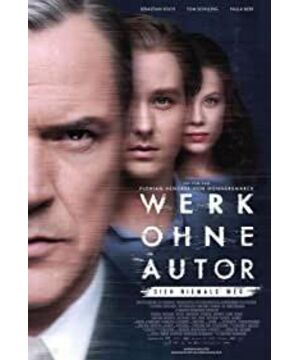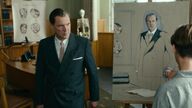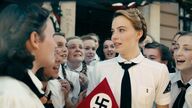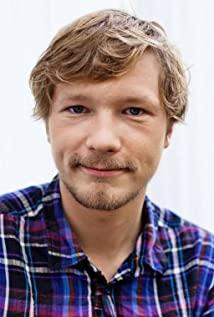Come and lick the face of little brother Xilin~
Hello everyone, I'm Daxianer.
Do you have the habit of visiting exhibitions often?
When you watch the exhibition, do you focus on watching the exhibition? Or focus on punching selfies?
When you look at contemporary art, do you marvel at other people's worldviews, or do you think this is art?
What do you think art is?
Do you think Da Xian'er is a little cold today?
That's because today's movies are about art, but don't rush to quit, the movies are good.
"Untitled"
Pay attention to this poster first, it's a bit bland, isn't it, isn't it the most commonly used routine for movie poster design - piles of people?
When you read this article, you will understand that it is very cleverly designed.
If you know the history of German contemporary art, you may have guessed who the prototype of this film is?
Gerhard Richter, one of the most important contemporary German artists.
Although in the movie, he was destitute and looked at his father-in-law's face everywhere, and also made money every day washing the floors in the hospital.
In reality, Richter was once one of the "hottest" living artists.
In 2015, his work "Abstract Painting" set an auction record of 30.04 million pounds.
This film is not just about Gerhard Richter's life being shown on the big screen in an artistic form, but through him to reflect on the impact of the pain of war on the German people since World War II.
The film's timeline spans from 1937 to 1966, from the eve of Hitler becoming Germany's head of state and launching World War II, to the Berlin Wall dividing Berlin in two.
When it comes to East Germany and West Germany, there is one movie that cannot be bypassed, "The Storm of Eavesdropping".
Coincidentally, this film is the same director as "Eavesdropping Storm".
Florian Henkel von Donnersmarck, a director whose name is still difficult to remember.
Not only does he have a long name, but he is also one of the best in the director world.
Let's see if he had a feeling of seeing the mountains and mountains when he came to the Beijing Film Festival as a judge. At 168cm, Xu Qing looked like a bird.
Looking through the director's resume, from 2006 to now, there are only 3 works, including the unsuccessful "Deadly Companion".
After "Eavesdropping Storm" won the best foreign language film at the Oscars, Donners Marc brought his family to Hollywood.
In fact, after many foreign directors came to Hollywood, they were unaccustomed to the environment. It has been 8 years from "Deadly Travel" to "No Master".
After Donnersmark returned to Germany, he found Bei again and returned to the top 5 of the Oscar foreign language films with "No Master".
Now that you know who the prototype of the story is, how does he tell it?
The film begins in Germany in 1937, when a movement is sweeping the German art scene.
What sport? Anti-decadent art movement.
What kind of art will be reversed? All art forms that do not conform to the ideology and aesthetics of Nazi Germany are classified as decadent art.
At that time, as long as he was regarded as a decadent artist, his artistic career in Germany was over, except in exile.
The Nazis would hold a "decadent art exhibition" and publicly execute these "decadent art", which attracted more than 2 million people to "criticize" art together.
So what are the works of artists that are classified as decadent art?
The beginning of the film tells us the answer.
Such as Franz Mark, the master of German expressionism.
Take Otto Dix, for example, the master of the German New Objectivism.
Like Kandinsky, the master of Russian constructivism.
In addition, Bauhaus, Cubism, Dadaism, Fauvism, Impressionism, Surrealism are all wiped out.
If you count Richter's birth date in 1932, Kurt in the film is exactly 5 years old.
Kurt's first artistic enlightenment in his life was the "Decadent Art Exhibition", but he was warned not to paint like this, and art should serve ideology.
His artistic outlook would not undergo a major shift until he fled to West Germany.
Elizabeth, Kurt's mother's sister, is very close to Kurt, his first muse.
Elizabeth, who likes decadent art, told Kurt not to look elsewhere, all real things are beautiful.
Born in Nazi Germany, his childhood was not destined to be a good one, even if he did not join the Hitler Youth League and was dragged to the front to fight.
In 1945, before Germany surrendered, Dresden, where he was born, was bombed into a sea of fire by the Allies. Kurt's two older brothers were killed in the battle, as was his second aunt, Elizabeth.
However, he could only stare at the aluminum foil strips that the Allies scattered to interfere with the radar, while looking at Dresden, which was caught in a sea of fire.
Just as his second aunt told him, he "sees" everything in his eyes.
"What is art?", the question that has haunted Kurt from Nazi Germany to the GDR.
By this time, he had become an art school student.
Due to many experiences in his childhood, he has a kind of "ability".
As long as there is a painful scene, he will raise his hand and block it in front of his eyes, and the prospect will be blurred.
The director presents Kurt's childhood trauma in a way that is entirely cinematic.
And his childhood trauma can also be extended to the spiritual predicament faced by the younger generation in Germany after the war.
During the war, he did not want to be the successor of the Nazis who had no emotions and only knew how to obey, but had no ability to fight.
After the war, I don't want to look back on the past, but the past is like a shadow, and I follow it all my life.
This contradiction has always been in Kurt's heart.
Although his aunt told him not to look away and face life head on, Kurt always wanted to get rid of his past.
Just as he and his girlfriend finally chose to escape from East Germany to West Germany.
When he was a student at the art academy in Dresden, Dresden was in Soviet occupation.
The art he learned in school was to serve socialist realism.
This is what the professor taught in the first class. You can't be full of "I", "I" and "I", and you have to serve the people.
For this professor, this is creative freedom.
For Kurt, he never felt freedom, let alone creative freedom.
Like, he's a painter, a painter who paints murals in a history museum, not a painter.
A painter is to express "I"'s feelings about the world, and a painter is a type of work that leads the work.
After he fled to West Germany, "freedom" came upon him.
Watch movies that East Germany can't see.
Eat what East Germany can't eat.
Everything smells of freedom.
Kurt chose to go to Düsseldorf, the cutting edge of German art.
Here, how does the pioneer come.
But what kind of freedom is real freedom?
He made some good friends here.
A person is never free to too free, and it is not necessarily a good thing.
Kurt started his own art, or imitated art.
He began various experiments, printing dancing footprints on paper and soaking deer antlers in white paint.
While embracing Western civilization, he deliberately gave up his previous life experience.
Little did he know that in the past he watched his aunt being carried away by the medical staff, he watched the fire in his hometown, and he looked at his socialist realism works. These countless he combined into the real him.
Once, a professor at the college went to his studio, and he didn't hear any compliments.
The professor said that the works he saw were not him, and told Kurt his story. He told Kurt that real art comes from everyone's life experience, and this is the real him.
Everyone's life experience is in the blood, in the bones, and cannot be rid of.
Just like what the professor said when interviewing Kurt.
Your eyes tell me that you see more than all of us.
Only when you face yourself directly can you be who you really are, and you can gain true freedom, no matter what you saw in the past?
Everyone's life trajectory is different, which also makes everyone's three views different.
Boyce said that everyone is an artist.
As long as a person can display his subjective ability at will, no matter what his identity is, he is an artist.
Eventually he found his own artistic expression - photo painting.
He collected a lot of old photos after World War II, some of them taken by himself, some photos of him and his family, and some photos added from newspapers and magazines.
In his photo paintings, the human figures are blurred and the tones are mainly gray, which is how he discovers the history that people want to forget.
He reproduces reality with vague realism and gives new meaning to it.
I have to say that the director used a very Richter way to show the thirty years in his life that formed his artistic outlook.
And these 30 years are also very important 30 years for the whole German nation.
In these thirty years, we have to face the reconstruction of post-war material life and the reconstruction of inner values.
Why did Germany start World War II 20 years after World War I? Why was the mad Hitler in power?
German Chancellor Angela Merkel once said, "Every German must reflect on his actions and inactions in the past. It is a painful process, but Germany is right to face up to history, so that future generations will not repeat the same mistakes."
Kurt in the film really does the service of the people with art.
Just like the title of the film, his works have no owner, they belong to the people and history.
-FIN - Public account: Xiaoxianmovie (xiaoxianmovie)
View more about Never Look Away reviews










